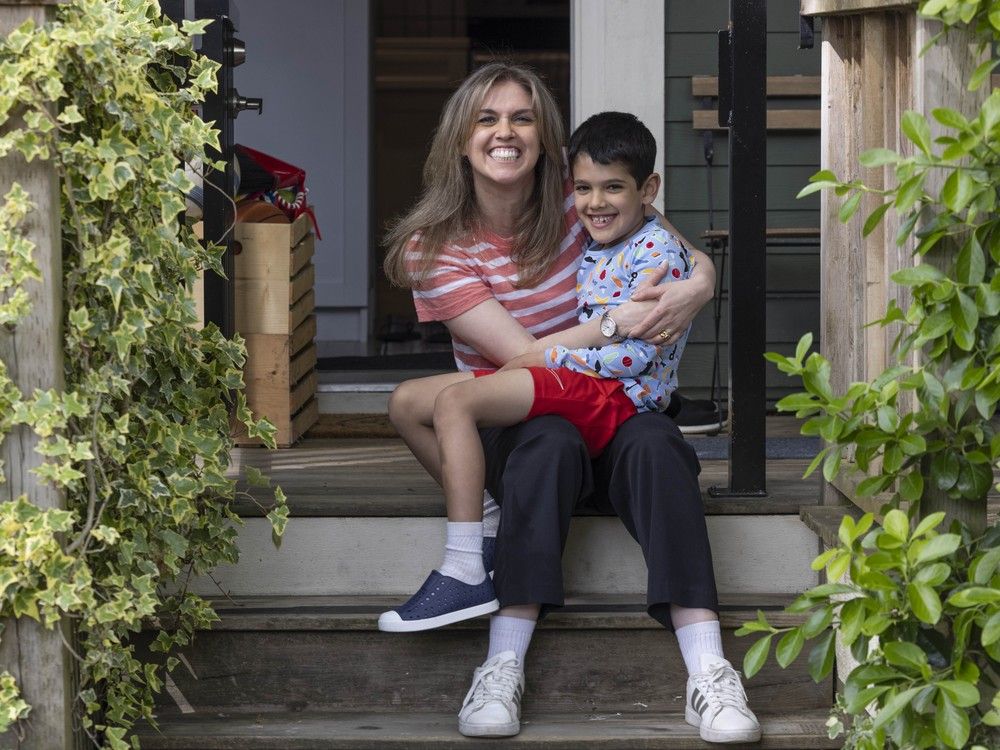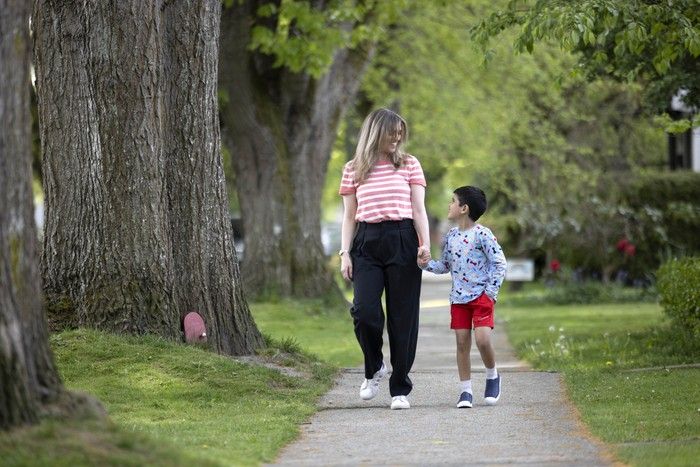
Laura Spencer’s son Ethan is six. But in the years before he was conceived using invitro fertilization, she found Mother’s Day one of the hardest days of the year.
She can easily recall how desperately she wanted to be a mother and the pain associated with not being one on a day when motherhood is “everywhere.”
Spencer said this year’s celebration comes at a time of great hope and frustrating uncertainty for many people struggling with infertility as B.C. prepares to launch a publicly funded IVF program in early summer.
“We are on the right path with funding for IVF,” said Spencer, “but there are still so many unanswered questions.”
B.C. IVF clinics are bracing for a fourfold increase in patients when the program opens on July 2, but information about eligibility is still limited, including how the funds will be dispersed and how government might prioritize people on a possible waiting list. Some of the excitement that greeted the announcement more than a year ago has turned to anxiety.
As a fertility coach, Spencer often speaks to people who are overwhelmed and looking for information.
“Many are trying (to conceive) month after month for a long time and there’s a lot of grief,” she said.
She said it can be difficult to understand the IVF process. “There’s also fear that it won’t work, and if it doesn’t work, there are questions: ‘Do we keep trying, or not?’ ”
One of the most significant barriers to IVF is the high cost of the medical treatment, which can range from $12,000 to $15,000 or more.
The new program will provide one-time funding of up to $19,000 for eligible B.C. residents for a single standard cycle of IVF treatment at a B.C. fertility clinic.
B.C. has the lowest fertility rate in Canada at one child per woman, compared with 1.26 children countrywide in 2023, which was a record low. B.C. also has the highest age of first birth, according to data from Statistics Canada.
Dr. Ken Seethram, medical director at the Pacific Centre for Reproductive Medicine, a B.C. fertility clinic, said B.C. has done a thorough job consulting various experts and studying programs in other provinces. B.C.’s program will be “unique,” with a central application system that will let government monitor and assess the needs as it proceeds.
“For many women and couples, the province’s decision is an acknowledgment that infertility is a disease and is worthy of being treated,” he said.
It’s believed that infertility affects one in six heterosexual couples in their lifetime. The true prevalence of infertility is likely higher if a more inclusive definition is used, said a recent article in the B.C. Medical Journal that noted members of the LGBTQIA2S+ community and single individuals will need access to fertility treatments to build their families.
According to the HealthLink B.C. website , birthrates resulting from a single cycle of IVF using a woman’s own eggs are about 30 to 40 per cent for women age 34 and younger, with rates decreasing steadily after age 35.
Seethram said several factors impact the success of IVF, making each case unique. He noted that if you look at the “cumulative success rate,” meaning if you include not just fresh embryo transfers but frozen embryo transfers after the initial egg retrieval, the success rate goes up to about 80 per cent.
Dr. Niamh Tallon, co-director of the Olive Fertility Centre, said $19,000 in one-time funding may not cover all the costs associated with IVF, particularly for an older person who might require a more rigorous treatment protocol.
She believes the $68 million promised by the province over the next two years will not be enough to cover every one who applies to receive funding for an IVF cycle in that time. B.C. IVF clinics currently do about 4,000 rounds of IVF each year and the funding would cover less than half of that.
“The demand could right away exceed (the funding),” she said.

Jason Au, a board member with the Canadian Fertility and Andrology Society and a lab director with a Vancouver-based fertility clinic, said B.C. clinics have seen a reduction in patients as the program launch date approaches, indicating some people may be waiting. Interest is expected to surge after July 2, similar to the experience in other provinces with funding.
“It seems like we’re going to see the same pattern,” he said.
Clinics are preparing for the surge, but they’re limited by the details that have been released by government so far, particularly concerning payment. Au also noted there is a countrywide shortage of embryologists.
Tallon said her clinic has been fielding calls from people asking to be placed at the top of the list when the program opens, but there is no waiting list yet: “We don’t really know what to tell people.”
The doctor expressed concern that the government’s rollout of the program, a year and three months after first announcing it, has contributed to more anxiety.
“Infertility can be very isolating,” she said. “One of the pressure points is waiting.”
That’s particularly true for Mission’s Ally Matos, who was excited when the government first announced the program. But the waiting has worn her down.
“I feel really depleted and exhausted,” she said.
As she approaches 38, she knows time is important. But when she was younger, there was no way she could afford IVF.
“I’ve waited 10 years, but I don’t know if this will be in my timeline,” she said. “Will people rush (when the program opens)? Will there be a long wait? Should I wait or should I pay?”
Tallon acknowledges the complexities the government must consider, particularly around ensuring equal access to marginalized populations.
People who don’t have a doctor or live in a rural area may struggle to get a referral to a fertility clinic. Some family doctors send women to a gynecologist first, where they may spend one or two years on a waiting list to be seen. She wants people to know that they can seek a referral to a fertility clinic from telehealth.
“Otherwise some people may not get the treatment within the two years of funding,” she said.
It’s unclear if the program will be extended and funded beyond two years.
The Health Ministry said it was aware of the anxiety and stress caused by a recent three-month delay of the program start date from April 1 to July 2. It plans to provide more updates as they become available in the lead-up to that date, but said that in the meantime its website remains the best source of information.
Tallon said some people may choose to go ahead and pay out-of-pocket because the chances of success might decrease with waiting longer.
“This information really can’t come soon enough,” she said.
Three years ago, after several unsuccessful rounds of IVF and other treatments, Abbotsford’s Sarah Tremblay had to “walk away” from her hopes to have a child. In the years since, she’s been sharing her story on Instagram at @sarahtremblay05.
“I remember sitting on my bathroom floor after my last IVF treatment and realizing I didn’t want to do it anymore,” she said.
The decision was incredibly difficult.
“I had laid my worth on the title of being a mom.”
She advises people who are starting their IVF journey to share their feelings, rather than trying to appear strong.
“I stayed silent about so much of it, because I was ashamed. But it is nothing to be ashamed of.”
She remembers well-meaning people telling her not to give up. She said the encouragement stung because she was doing everything she could.
“I fought so hard.”
Tremblay also urged the B.C. government to think about the toll uncertainty and delays can have on mental health as it launches the new program.
She said she used to “hide away” on Mother’s Day, but is now at a point where she can celebrate with the mothers in her life, as well as celebrate her own womanhood.
“If you know someone walking through this right now, check in on them on Mother’s Day,” she said.
Related
B.C.’s new publicly funded IVF program will provide one-time funding up to $19,000 for eligible B.C. residents for a “single standard cycle” of IVF treatment at a B.C. fertility clinic. Applications open July 2.
Here’s what we know about the eligibility criteria so far:
- Applicants must be B.C. residents enrolled in MSP
- They must be 41 or younger at the time of the application
- The application must be submitted on a person’s behalf by a fertility specialist
- People with private health insurance remain eligible and can combine their coverage with the funding
- People who have had a previous IVF treatment remain eligible, as do those who have had tubal ligation
- People with existing frozen embryos, eggs or sperm remain eligible and must work with a fertility specialist to determine the most effective use of any existing genetic material in combination with the public funding
- People using known donor eggs or sperm remain eligible, although the program will not cover the cost of the donor eggs or sperm
- Applicants are expected to complete any other fertility treatments recommended by their fertility specialist before applying for publicly funded IVF treatment
Funding may be applied to any part of a standard IVF cycle (including orientation, egg retrieval, sperm retrieval, fertilization, blastocyst culture and single embryo transfer, fresh or frozen), components of a standard IVF cycle with previously frozen eggs, frozen embryo transfer using previously frozen embryos and required medications.